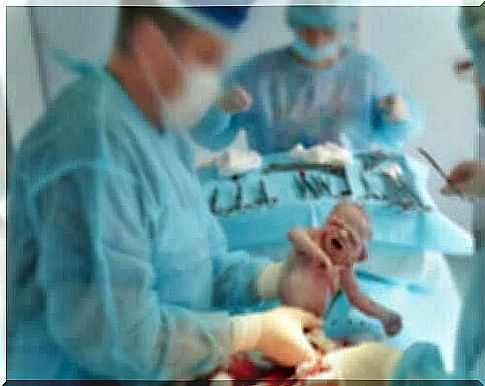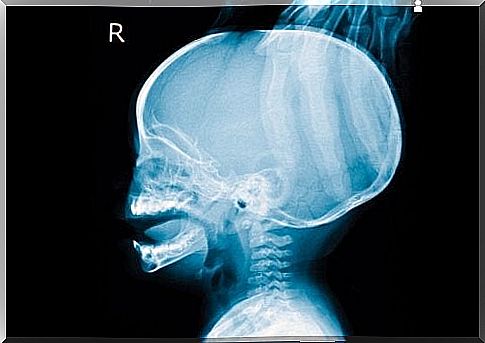Diseases Of The Newborn Treated With Surgery

Most neonatal surgical diseases are related to malformations in prenatal development. In addition, there are countless reasons that make surgical intervention in the neonate necessary. Below we will explain just some of the newborn diseases treated with surgery, sorting them by systems.
Digestive Surgical Newborn Diseases
Defects in the anterior abdominal wall
In this sense, there are omphalocele and gastroschisis. The omphalocele is the projection through an abdominal opening of some organs. Furthermore, these organs are covered by a membrane. In gastroschisis there is no such membrane.
esophageal atresia

In the context of an esophageal atresia, the esophagus does not develop properly. In this way, it ends up at your top without actually connecting with your stomach.
Esophageal atresia is often associated with another defect called a tracheoesophageal fistula. This determines an abnormal connection between the esophagus and the trachea. In this way, the digestive content ends up in the respiratory system.
Hypertrophic pyloric stenosis
The pylorus is the orifice that communicates the stomach with the intestine. In the course of this disease, the muscles around the pylorus are hypertrophied (its size is increased). Therefore, the passage of food from the stomach to the intestine becomes difficult.
In addition, pyloric stenosis brings with it consequences such as frequent vomiting, malnutrition or abdominal pain.
Megacolon: Hirschprung’s Disease
Peristalsis is a term that refers to contractions that are performed in the intestine in order to move food. In short, for these movements to be produced, the presence of neurons in the intestinal wall is necessary. This is precisely what Hirschprung’s disease lacks, at least in one part of the intestine.
As a consequence of not having peristalsis in an area, a blockage is generated in the region. As a result, food cannot move forward and, from the blockage, it accumulates. This creates an important intestinal obstruction. As a result, the abdomen swells and bowel movements become complicated.
Cardiovascular Surgical Newborn Diseases
Congenital heart diseases are the main congenital malformations that generate infant and neonatal mortality. This is explained by its relatively higher frequency and its higher specific mortality.
Coarctation of the aorta
The aorta is the artery that carries blood from the heart to most of the blood vessels in the body. In summary, a coarctation of the aorta refers to a punctual narrowing of this artery, usually at the beginning of its course.
Symptoms depend on how much blood can flow through the coarctation. If it can flow sufficiently, it won’t be diagnosed until about adolescence.
Otherwise, the newborn will experience rapid breathing and eating problems. In addition, you may become drowsy and react poorly to stimuli. If the coarctation is very severe, the newborn may experience heart failure and shock.
Interatrial and interventricular communication
The heart has two atria (right and left) and two ventricles of equal distribution. In addition, the cardiovascular circuit determines that in the left cavities there is oxygenated blood and in the right ones blood without oxygen.
Therefore, when there is a communication between the right and left atrium (or ventricle), these two bloods mix. This means that oxygen cannot properly reach all cells. Thus, the newborn will show symptoms such as difficulty breathing and shortness of breath caused by the activity, for example, when eating.
pulmonary stenosis
There are valves that give blood passage from the heart to the arteries. However, there may be a case where these valves cannot fully open. This is called a valve stenosis. In this case, it happens with the valve that gives passage to the pulmonary artery: the one that takes unoxygenated blood to the lungs to be oxygenated.
Most cases of pulmonary stenosis are mild and are found on auscultation of the neonate.
Urological surgical newborn diseases
Migration and Merger Anomalies
In prenatal development, kidneys are formed in the lower abdomen. Later, they ascend until they finish at the top. However, failures may appear along the way, with renal ectopies appearing . This term refers to kidneys located in abnormal places.
Furthermore, the kidneys, while ascending, can meet. In this way, it is possible that they merge, giving way to a single kidney. When united at the bottom, they give rise to the so-called horseshoe kidney, due to the shape it acquires.
Multicystic renal dysplasia
A kidney with multicystic renal dysplasia is composed of cysts and dysplastic (anomalously maturing) tissue. In this way, the kidney does not work, and tends to go backwards in its evolution. The ureter (the conductor that joins the kidney to the bladder) usually appears narrow or does not develop at all.
Surgical diseases of the nervous system
hydrocephalus

Hydrocephalus is the accumulation of fluid in the deep cavities of the central nervous system. In short, this fluid compresses the brain. At first glance, it can be noticed by the increased size of the neonate’s head.
In addition, it can produce varied symptoms, from vomiting to drowsiness and irritability or seizures.
Spina bifida
When the spine does not close completely, part of the spinal cord protrudes through the spine. If the projection is a small amount of nervous tissue, symptoms may not appear. If there is a large amount, there may be motor difficulties or urinary symptoms, among others.









